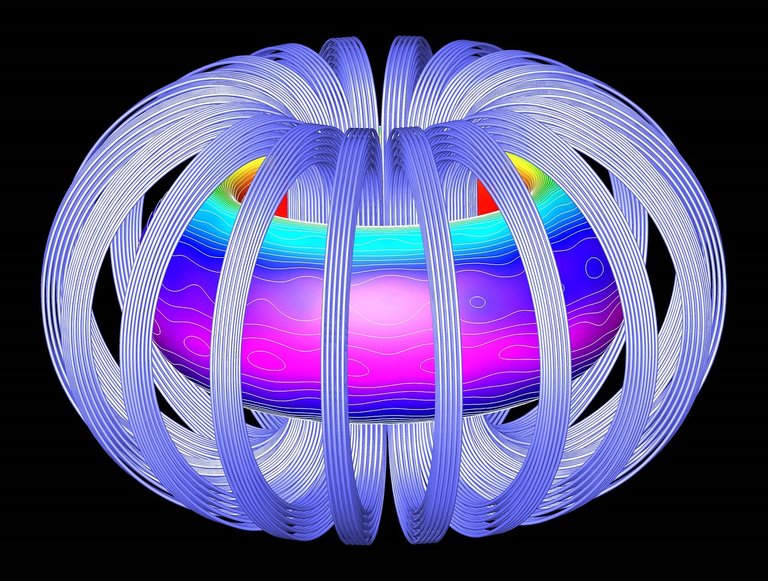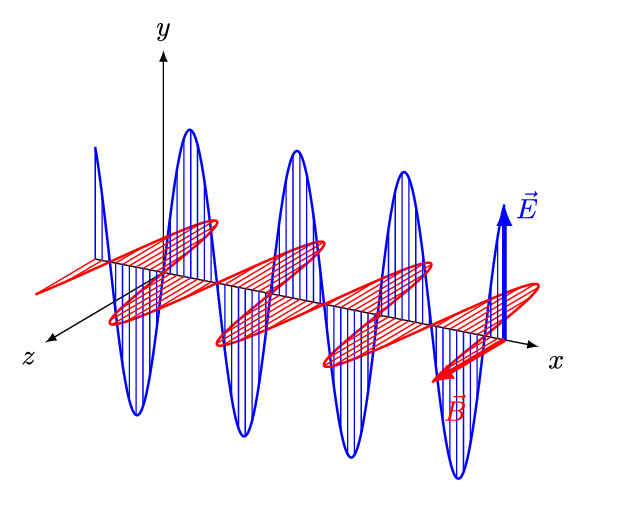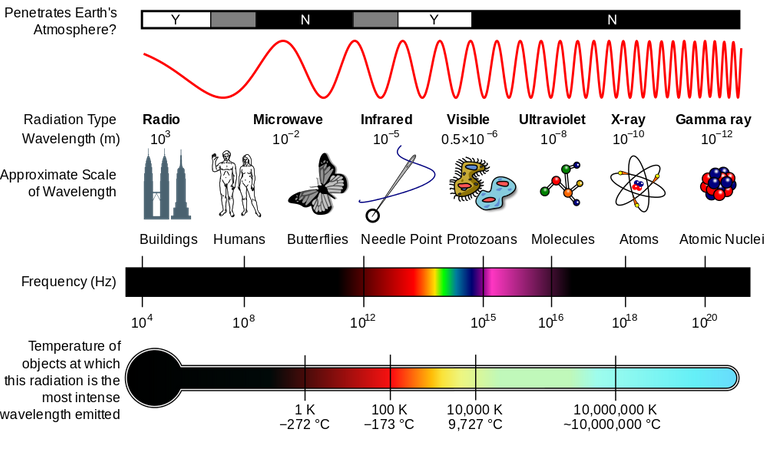Hello and welcome. It is wonderful to have you here.
Perhaps the most under-appreciated scientific breakthrough of the last century is Electromagnetism. This is not surprising. It seems to be a human nature that we do not bother with stuff as long as they are working well. Take gravity for instance: how many times have we heard any person say that they are grateful for gravity? As lame as it sounds, every human being should be grateful for gravity or gravitational force because what our earth would be without it is better left to the imagination. Electromagnetic waves find uses in the following areas of life:
- Satellite signals (Microwaves)
- Cooking (Microwaves)
- Infrared Radiation (remote controls, toasters)
- Ultraviolet
- X-rays detect bone breaks
- Gamma Rays
- Radio Waves (communications)
- TV and FM radio (short wavelength)
- Direct line of sight with transmitter

This post arose from two seemingly unrelated events:
While engaging a fellow Steemian who wrote this post here on introduction to basic electronic components, he said that he never thought of me as someone with some knowledge of engineering since I almost always write science and medical posts.
While discussing another post on how human beings may, shortly, be capable of transmitting electric power over distances using high-frequency electromagnetic waves, a friend said:
Sometimes, you just have to go with the simplistic opinion that science and technology is juju (magic).
Electromagnetism
How the Magic Began
Electromagnetism is the science of charge and the forces that are associated with charges at rest or in motion. Obviously, electromagnetism came about from electricity and magnetism. Before Albert Einstein's theory of relativity, electricity and magnetism were thought to be two different things until he unified them as phenomena that were interrelated.
Electricity
Electricity is the study of charges at rest or in motion. The concept of charges shall keep recurring so it is worth looking at. Everything in our Universe is made up of atoms. An atom has a nucleus at the centre that is made up of at least one proton and a neutron, then it has electrons or at least one electron orbiting around the nucleus much like the planets in our Solar system. The atom is normally neutral because the neutron is neutral, but the proton is positively charged while the electrons are conventionally regarded as negatively charged particles which equal the positively charged proton in number and charge. You know how they say that the devil is in the details? It's true. Maybe it is better just to call this whole thing juju and move on.
We have only just begun. So, if everything is neutral (without a net charge), then why do we keep talking about charges and how does it result? It is the electrons that are suspect. The planets orbiting the sun in our solar system do not suddenly leave their orbits for any reason. This is because the forces that hold the planets in place are much stronger and everything concerning that is just perfect. This perfection of everything in the universe is what is called the Goldilock Enigma.
But thank Goodness for atoms. Atoms are fickle, and the electrons are bound by weaker forces than the one that attaches our universe. So if we take two insulators(materials that do not conduct electricity, like fabrics) and rob them together swiftly, some electrons may leave one article and move onto the other elements. When this happens, the two materials have acquired net positive and negative charges respectively. This is electric charges at rest and is covered by a branch of physics called Electrostatics. On a dry day, if those two fabrics are brought close, small crackles and sparks are heard as the electrons try to balance out and leave the materials neutral once again.
Electric Field, Electric Force, Electric Potential and Electric Current
Electric Field is defined simply as the region where electric force can be felt. It is the field that exists between two charged bodies like the two fabrics in our electrostatic experiment. This field would act or repel a test charge by exerting a force, depending on the polarity of the charge. This force acted upon a test charge is a non-contact force and is called Electric Force. It is this force that causes similarly charged balloon to repel each other when placed nearby.
Electric Potential is similar to Gravitational Potential that bodies experience in a Gravitational Field. In nature, we know that an object released at height would fall. It does not require to have any energy or for it to be pushed: it falls as if by its own accord. But not really, it falls because it is acted upon by the gravitational force which the earth exerts on every smaller object near its surface. In fact, for the object to move upward from the earth, some work needed to have been done to move it against gravity to a higher position. Therefore, at that high position, the object would possess energy equal to the work that was done to elevate it.
This energy is called Potential Energy and is the energy that the body would lose to fall back to the earth. Potential energy is the energy of position and depends on the position of the body in the field. If we have a source of a positively charged generator, electric potential energy would be the energy expended in moving a positive test charge against the repulsive force of the generator.
Electric current is the flow of charges due to the potential difference between two points in a conductor (a material that allows passage of electricity) or a Electric Circuit. Great! We are progressing.
Magnetism
Magnetism is a branch of physics which studies magnetic fields. Earlier, it was mentioned that electricity and magnetism are interrelated. It's true. In fact, everything in physics is unified to create the sights, sounds, forces and our general experience of the universe. The interactions between charges at rest separated by a distance creates an electric field. But when these charges move as in Electric current, both a Electric Field and a Magnetic Field are created. A magnetic field is an area where the effects of moving charges in an electric circuit or magnetic dipoles are felt by other charges or magnetic dipoles.
Now we can get back to Electromagnetism having established how it is two phenomena rolled in one.

Wikimedia CC0 Creative Commons: How Electric Field Combines with Magnetic Field to Produce Electromagnetic Field, while the electric field E lies in the x-y plane, the magnetic field E lies on the x-z plane
Electromagnetic Field, Electromagnetic Energy, Electromagnetic Waves and Radiation
You somehow stumbled on a time machine and went back in time to 1750. After seeing the way they lived, you decided to wow one of your forebears by bringing him back to 2018. You succeeded, but there is a small problem. He would probably die of shock when he sees you face-timing your friend on the other side of the country. This, of course, is assuming that he survived the other shocks that would hit him upon arrival.
The point is that the advancement which has been made over the last century alone in the field of science and technology would be overwhelming to any person who sees the application of these years of understanding physical laws. But if we are to take it one step at a time, comprehending the relationship between different forces, we would still be wowed, but hopefully, our hearts would still be intact after the experience.
By the mile it's hard but inch by inch, everything is a cinch.
Electromagnetic Field, Electromagnetic Waves, and Electromagnetic Radiation are confusing words because the ought to mean the same thing, but there are subtle differences.
As we established earlier, electric and magnetic fields are interrelated. Charged particles create electric fields. Moving charged particles create both electric and magnetic fields. It is for this reason that a a compass placed near a cable carrying DC current, you'll see the needle deflected by the magnetic field created by the moving charges in the cable. But this is not the most interesting thing about the electromagnetic field.
It turns out that when the electric field changes in time, it creates a magnetic field. The magnetic field, in turn, creates an electric field when it changes in time. The two fields wrap or curl around each other such that the two fields are perpendicular to each other according to precise mathematical rules embodied in Maxwell's equations. This is called "Electromagnetic Induction". Due to this occurrence, Electromagnetic Waves can propagate very far away from the source at the speed of light.
Finally, the electromagnetic field exists in the space between two charged bodies. As mentioned earlier, the body could acquire a net positive or negative charge by losing or gaining some electrons. To generate an electromagnetic wave from this charged body, all that is needed is a shake. The slower the shake, the longer the wavelength of the electromagnetic waves generated and this could range from microwave frequencies to radio and if you shake fast enough, you may be able to generate light waves. And no matter the frequency the electromagnetic waves propagate, it contains energy that is useful in a myriad of applications. Below is an image of different electromagnetic waves showing different wavelengths:

Wikimedia Commons: Electromagnetic Waves and their Properties
Using the right equipment, we could generate the right wavelength of electromagnetic waves to cook food on our microwave oven. We can also use equipment that produces a frequency on which radio signals can ride and be delivered over long distances. So if someone has figured out a way to produce electromagnetic waves on which electric power can ride and be delivered to users, I say, Why not?. It is not the biggest magic we have experienced, and we would know that if we did not take the past miracles for granted.
References:

)
)
)
thanks for refreshing my memory its been long
Thank you for reading through.
We can never run away from Maxwell equations when it comes to the study of electromagnetism. An expository read and simplified so well as it would make sense to a lay man. Thanks for putting it up in this unique fashion and thanks once again for sharing.
Yes, you're right about Maxwell's equation. It neatly sums up the electromagnetic phenomena. Thank you for your comments.
Thank you for the support.
Congratulations @churchboy! You have completed some achievement on Steemit and have been rewarded with new badge(s) :
Click on any badge to view your own Board of Honor on SteemitBoard.
For more information about SteemitBoard, click here
If you no longer want to receive notifications, reply to this comment with the word
STOPYou would become a lecturer at this rate, churchboy. Its nice to read something which would remind me of my memories while studying the Diploma in Electrical and Electronic Engineering. Thanks for refreshing my memories. Upvoted!
Thank you. I am just trying to remind myself of the things I used to know! You should try it since this is your field. You're a great friend.
Thanks a lot mate. I want to share in Steemit the beautiful places in Singapore and my interesting life in general. I will slowly step by step release my content and my field of studies will be hopefully the end game content. That is my plan. Thanks, you are a great friend too.
That's an awesome plan. I'm sure Singapore is beautiful. So if you have the time to take pictures and tell us about some secret places in Singapore, that would be awesome. But since you are looking for a job, that may be a challenge. Did I tell you that I stopped looking for a job when I found steemit? Yeah, I did.
Wow I really enjoyed reading this science refresher. I loved it in school. At first I almost stopped reading due to length, but am glad I didn't.
Refresher question, what causes people to shock one another, or be shocked by objects? I notice it happens to me a lot when the air is dry.
:) Hello there @pixiehunter. As mentioned in the experiment, when two materials are rubbed together, especially insulators, some electrons leave one of the material and enters the other one, leaving the first material with a net positive charge and the second material with a net negative charge. If, for instance, your bare feet were one of those materials and the rug in your living room was the other material, shuffling across the floor would give your feet or your body that net charge. So when you grab the door knob on a dry day, there would be a transfer of charges from your body to the door knob, giving you a little shock. Thanks for visiting my blog. You're appreciated.